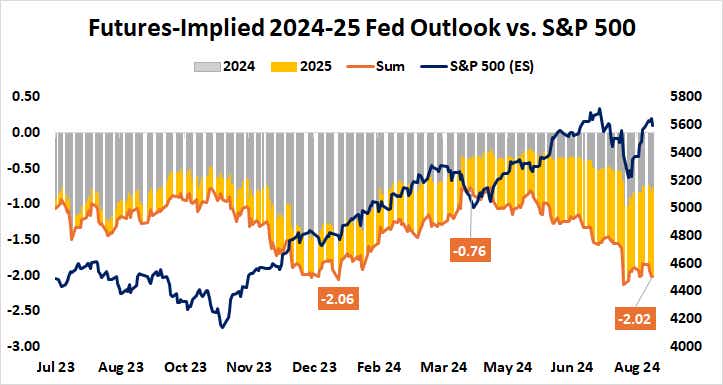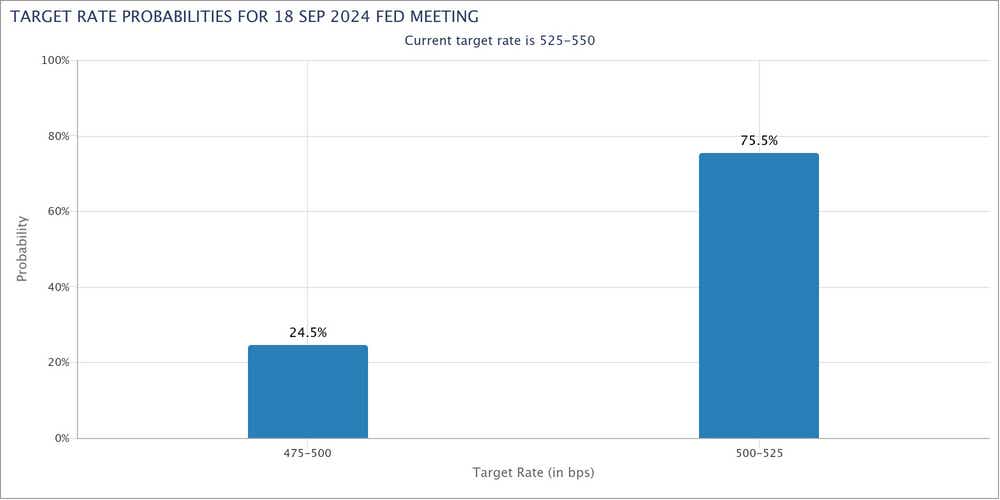Stocks Want a Dovish Fed Chair Powell at Jackson Hole. They May Not Get Him.

Stocks Want a Dovish Fed Chair Powell at Jackson Hole. They May Not Get Him.
By:Ilya Spivak
The S&P 500 and the Nasdaq 100 are on pace for their biggest daily loss since the bloodbath on Aug. 5
Stocks and bonds fell as the dollar rose before Powell speaks at the Jackson Hole Symposium.
Markets fear the U.S. central bank will cut rates too late to contain the risk of recession.
Wall Street may suffer if the Fed chair signals a 50bps rate cut is off the menu for next month.
Stock markets got cold feet ahead of a much-anticipated speech from Federal Reserve Chair Jerome Powell at the U.S. central bank’s annual symposium in Jackson Hole, Wyoming. The bellwether S&P 500 and the tech-oriented Nasdaq 100 equity benchmarks are on pace for their biggest daily loss since the bloodbath on Aug. 5.
Against this backdrop, the U.S. dollar is enjoying its best performance in three weeks relative to an average of major currencies and Treasury bonds thaare broadly lower as yields rise across maturities. These moves seem to reflect pre-positioning as traders brace for the possibility of a letdown from the Fed chief.
Markets fear the Fed is already too late to contain recession risk
The markets have been animated by the possibility that the central bank is already behind the curve on interest rate cuts—holding rates at their hiking cycle peak too long and risking a painful slowdown in economic growth—since early July. That’s when Powell hinted in congressional testimony that rising risks to job growth mean easing is imminent.

For their part, traders had been betting since mid-April that the Fed’s resistance to rate cuts in the first half of the year would demand catch-up stimulus in 2025. From that time through the end of June—notably before July’s fireworks—the total amount of rate cuts priced in through the end of next year nearly doubled from 75 to 133 basis points (bps).
A sense of urgency gripped investors once Powell signaled that Fed officials had reached their pain point, as though the central bank’s recognition meant the economic danger foreshadowed in the markets’ rate path pricing has been validated. That fueled speculation that September would bring a double-sized 50bps rate cut.
Stocks may fall if Fed chair waves off outsized rate cut
As it stands, Fed Funds futures pricing implies the probability of such an outcome at about 25%, while that of a standard 25bps reduction is set to 75%. Minutes from July’s meeting of the Fed’s policy-making Federal Open Market Committee (FOMC) seemed to endorse the latter, with a “vast majority” saying a cut is “likely to be appropriate.”

Nevertheless, “several participants” in the meeting said economic conditions provided a “plausible case” to have issued at 25bps rate cut in July, though this was ultimately shelved. Crucially, that meeting took place before the release of that month’s woeful jobs report and the follow-on turmoil across global markets.
With that in mind, it seems apt to consider that “several” dovish policymakers ready to cut rates in July may have turned into “many” or even “most” in retrospect. This makes a catch-up 50bps rate cut a viable possibility, and market pricing signals as much. If that is the path ahead, Powell’s Jackson Hole speech makes for an ideal stage.
On balance, the chair seems unlikely to ring alarm bells based on little more than one jobs report, even as he sets the stage for the start of an easing cycle next month. This may deflate risk appetite as bets on an outsized rate cut fizzle. That might weigh on stocks, lift the dollar and flatten the yield curve as more rate cuts are pushed off into the future.
Ilya Spivak, tastylive head of global macro, has 15 years of experience in trading strategy, and he specializes in identifying thematic moves in currencies, commodities, interest rates and equities. He hosts Macro Money and co-hosts Overtime, Monday-Thursday. @Ilyaspivak
For live daily programming, market news and commentary, visit tastylive or the YouTube channels tastylive (for options traders), and tastyliveTrending for stocks, futures, forex & macro.
Trade with a better broker, open a tastytrade account today. tastylive, Inc. and tastytrade, Inc. are separate but affiliated companies.
Options involve risk and are not suitable for all investors. Please read Characteristics and Risks of Standardized Options before deciding to invest in options.
tastylive content is created, produced, and provided solely by tastylive, Inc. (“tastylive”) and is for informational and educational purposes only. It is not, nor is it intended to be, trading or investment advice or a recommendation that any security, futures contract, digital asset, other product, transaction, or investment strategy is suitable for any person. Trading securities, futures products, and digital assets involve risk and may result in a loss greater than the original amount invested. tastylive, through its content, financial programming or otherwise, does not provide investment or financial advice or make investment recommendations. Investment information provided may not be appropriate for all investors and is provided without respect to individual investor financial sophistication, financial situation, investing time horizon or risk tolerance. tastylive is not in the business of transacting securities trades, nor does it direct client commodity accounts or give commodity trading advice tailored to any particular client’s situation or investment objectives. Supporting documentation for any claims (including claims made on behalf of options programs), comparisons, statistics, or other technical data, if applicable, will be supplied upon request. tastylive is not a licensed financial adviser, registered investment adviser, or a registered broker-dealer. Options, futures, and futures options are not suitable for all investors. Prior to trading securities, options, futures, or futures options, please read the applicable risk disclosures, including, but not limited to, the Characteristics and Risks of Standardized Options Disclosure and the Futures and Exchange-Traded Options Risk Disclosure found on tastytrade.com/disclosures.
tastytrade, Inc. ("tastytrade”) is a registered broker-dealer and member of FINRA, NFA, and SIPC. tastytrade was previously known as tastyworks, Inc. (“tastyworks”). tastytrade offers self-directed brokerage accounts to its customers. tastytrade does not give financial or trading advice, nor does it make investment recommendations. You alone are responsible for making your investment and trading decisions and for evaluating the merits and risks associated with the use of tastytrade’s systems, services or products. tastytrade is a wholly-owned subsidiary of tastylive, Inc.
tastytrade has entered into a Marketing Agreement with tastylive (“Marketing Agent”) whereby tastytrade pays compensation to Marketing Agent to recommend tastytrade’s brokerage services. The existence of this Marketing Agreement should not be deemed as an endorsement or recommendation of Marketing Agent by tastytrade. tastytrade and Marketing Agent are separate entities with their own products and services. tastylive is the parent company of tastytrade.
tastyfx, LLC (“tastyfx”) is a Commodity Futures Trading Commission (“CFTC”) registered Retail Foreign Exchange Dealer (RFED) and Introducing Broker (IB) and Forex Dealer Member (FDM) of the National Futures Association (“NFA”) (NFA ID 0509630). Leveraged trading in foreign currency or off-exchange products on margin carries significant risk and may not be suitable for all investors. We advise you to carefully consider whether trading is appropriate for you based on your personal circumstances as you may lose more than you invest.
tastycrypto is provided solely by tasty Software Solutions, LLC. tasty Software Solutions, LLC is a separate but affiliate company of tastylive, Inc. Neither tastylive nor any of its affiliates are responsible for the products or services provided by tasty Software Solutions, LLC. Cryptocurrency trading is not suitable for all investors due to the number of risks involved. The value of any cryptocurrency, including digital assets pegged to fiat currency, commodities, or any other asset, may go to zero.
© copyright 2013 - 2025 tastylive, Inc. All Rights Reserved. Applicable portions of the Terms of Use on tastylive.com apply. Reproduction, adaptation, distribution, public display, exhibition for profit, or storage in any electronic storage media in whole or in part is prohibited under penalty of law, provided that you may download tastylive’s podcasts as necessary to view for personal use. tastylive was previously known as tastytrade, Inc. tastylive is a trademark/servicemark owned by tastylive, Inc.